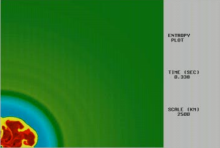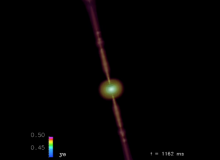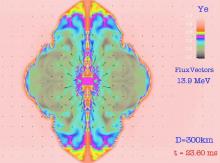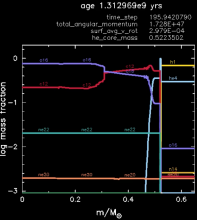Data
JINA-CEE scientific movies visualize data from various astrophysical computer models. They can be used for educational purposes.
Types of movies include nucleosynthesis movies that show how the abundances of isotopes evolve during an element creating process, and movies of the evolution of multi-D models of supernovae, neutron star mergers, and stars.
Note: some movies require a Macromedia Flash Player to view. Download QuickTime Player or Download Flash Player.
Nucleosynthesis Movies

r-process movie
See the r-process creating the heavy elements.

rp-process movie
See the nuclear reactions that generate the energy for an X-ray burst.

p-process movies
The p-process is responsible for the origin of the rare proton rich isotopes in nature, which are heavier than iron.
Supernova Movies

A radiation-diffusion/hydrodynamic simulation of the early development in 2D of the explosion of the core of a massive star.
The resulting supernova is dominated by instabilities and explodes as fingers into the outer burning shells. The blue-green interface marks the silicon-oxygen boundary of the progenitor star that is collapsing in to meet the supernova shock, which then encompasses it. The scale is 2500 kilometers.

The collapse of a rapidly rotating massive star core.
Due to strong centrifugal effects, this core bounces, then oscillates, after sending out a shock wave. The color map depicts the distribution of the electron fraction (Ye) and implies interesting asymmetries in the neutron-richness of the ejecta after explosion that may bear on the character of the r-process. The scale is 600 kilometers.

A representative 2D multi-group, flux-limited diffusion rad/hydro simulation of the collapse of a rotating Chandrasekhar core.
The color map shows the electron fraction (Ye) and the vectors are the electron neutrino flux vectors at an energy of 13.9 MeV. This is part of the first series of simulations done in the field of supernova theory that follows the collapse, bounce, and shock formation with a multi-D radiation field and determines the angular anisotropy of the neutrino fluxes.
X-Ray Burst Simulations
A popular model for X-ray bursts is based on the idea of an accretion disk dumping matter on to a magnetized neutron star. The matter cannot fall directly onto the neutron star because the magnetic pressure in the star's magnetosphere (i.e. the region where its magnetic field is dominant) opposes the inward motion of the accretion disk. As a result, the inner part of the disk is disrupted and instead follows the magnetic field lines. As a result, the matter accretes on to the pole cap of the star. The impact of the accretion stream on to the star's surface triggers rp-processes. The goal of JINA is to integrate dynamical processes with nuclear burning in order to arrive at a thorough understanding of X-ray bursts as well as supernovae.
Stellar Evolution Simulations

Evolution from the pre-main sequence to a hot white dwarf for a rotating, mass-losing stellar model with an initial mass 2.1 times the mass of the sun
Transformation of the chemical elements due to nuclear burning and the energy this process produces is highlighted in the first two panels in the first row. The entire history of the star is captured in the first panel in the second row. The stellar model was calculated using the Modules for Experiments in Stellar Astrophysics (MESA) software instrument, which is publicly avaliable at http://mesa.sourceforge.net.
